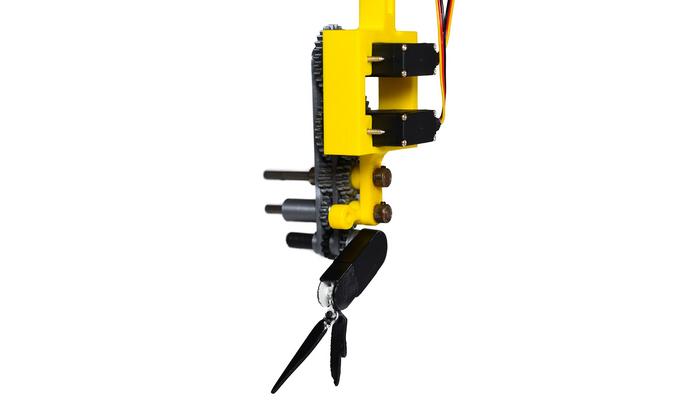PROVIDENCE, R.I. [Brown University] — Picture a network of interconnected, autonomous robots working together in a coordinated dance to navigate the pitch-black surroundings of the ocean while carrying out scientific surveys or search-and-rescue missions.

Credit: Photo provided by the Wilhelmus Lab.
PROVIDENCE, R.I. [Brown University] — Picture a network of interconnected, autonomous robots working together in a coordinated dance to navigate the pitch-black surroundings of the ocean while carrying out scientific surveys or search-and-rescue missions.
In a new study published in Scientific Reports, a team led by Brown University researchers has presented important first steps in building these types of underwater navigation robots. In the study, the researchers outline the design of a small robotic platform called Pleobot that can serve as both a tool to help researchers understand the krill-like swimming method and as a foundation for building small, highly maneuverable underwater robots.
Pleobot is currently made of three articulated sections that replicate krill-like swimming called metachronal swimming. To design Pleobot, the researchers took inspiration from krill, which are remarkable aquatic athletes and display mastery in swimming, accelerating, braking and turning. They demonstrate in the study the capabilities of Pleobot to emulate the legs of swimming krill and provide new insights on the fluid-structure interactions needed to sustain steady forward swimming in krill.
According to the study, Pleobot has the potential to allow the scientific community to understand how to take advantage of 100 million years of evolution to engineer better robots for ocean navigation.
“Experiments with organisms are challenging and unpredictable,” said Sara Oliveira Santos, a Ph.D. candidate at Brown’s School of Engineering and lead author of the new study. “Pleobot allows us unparalleled resolution and control to investigate all the aspects of krill-like swimming that help it excel at maneuvering underwater. Our goal was to design a comprehensive tool to understand krill-like swimming, which meant including all the details that make krill such athletic swimmers.”
The effort is a collaboration between Brown researchers in the lab of Assistant Professor of Engineering Monica Martinez Wilhelmus and scientists in the lab of Francisco Cuenca-Jimenez at the Universidad Nacional Autónoma de México.
A major aim of the project is to understand how metachronal swimmers, like krill, manage to function in complex marine environments and perform massive vertical migrations of over 1,000 meters — equivalent to stacking three Empire State Buildings — twice daily.
“We have snapshots of the mechanisms they use to swim efficiently, but we do not have comprehensive data,” said Nils Tack, a postdoctoral associate in the Wilhelmus lab. “We built and programmed a robot that precisely emulates the essential movements of the legs to produce specific motions and change the shape of the appendages. This allows us to study different configurations to take measurements and make comparisons that are otherwise unobtainable with live animals.”
The metachronal swimming technique can lead to remarkable maneuverability that krill frequently display through the sequential deployment of their swimming legs in a back to front wave-like motion. The researchers believe that in the future, deployable swarm systems can be used to map Earth’s oceans, participate in search-and-recovery missions by covering large areas, or be sent to moons in the solar system, such as Europa, to explore their oceans.
“Krill aggregations are an excellent example of swarms in nature: they are composed of organisms with a streamlined body, traveling up to one kilometer each way, with excellent underwater maneuverability,” Wilhelmus said. “This study is the starting point of our long-term research aim of developing the next generation of autonomous underwater sensing vehicles. Being able to understand fluid-structure interactions at the appendage level will allow us to make informed decisions about future designs.”
The researchers can actively control the two leg segments and have passive control of Pleobot’s biramous fins. This is believed to be the first platform that replicates the opening and closing motion of these fins. The construction of the robotic platform was a multi-year project, involving a multi-disciplinary team in fluid mechanics, biology and mechatronics.
The researchers built their model at 10 times the scale of krill, which are usually about the size of a paperclip. The platform is primarily made of 3D printable parts and the design is open-access, allowing other teams to use Pleobot to continue answering questions on metachronal swimming not just for krill but for other organisms like lobsters.
In the published study, the group reveals the answer to one of the many unknown mechanisms of krill swimming: how they generate lift in order not to sink while swimming forward. If krill are not swimming constantly, they will start sinking because they are a little heavier than water. To avoid this, they still have to create some lift even while swimming forward to be able to remain at that same height in the water, said Oliveira Santos.
“We were able to uncover that mechanism by using the robot,” said Yunxing Su, a postdoctoral associate in the lab. “We identified an important effect of a low-pressure region at the back side of the swimming legs that contributes to the lift force enhancement during the power stroke of the moving legs.”
In the coming years, the researchers hope to build on this initial success and further build and test the designs presented in the article. The team is currently working to integrate morphological characteristics of shrimp into the robotic platform, such as flexibility and bristles around the appendages.
The work was partially funded by a NASA Rhode Island EPSCoR Seed Grant.
Journal
Scientific Reports
DOI
10.1038/s41598-023-36185-2
Method of Research
Experimental study
Subject of Research
Animals
Article Title
Pleobot: a modular robotic solution for metachronal swimming
Article Publication Date
13-Jun-2023




